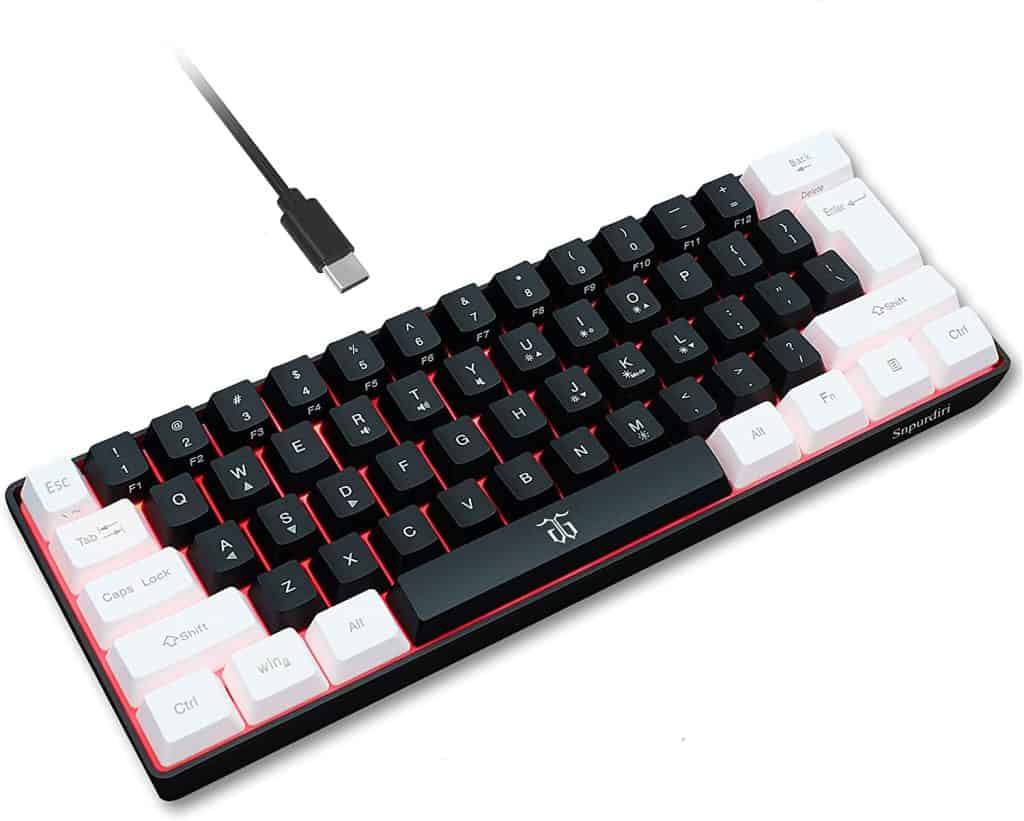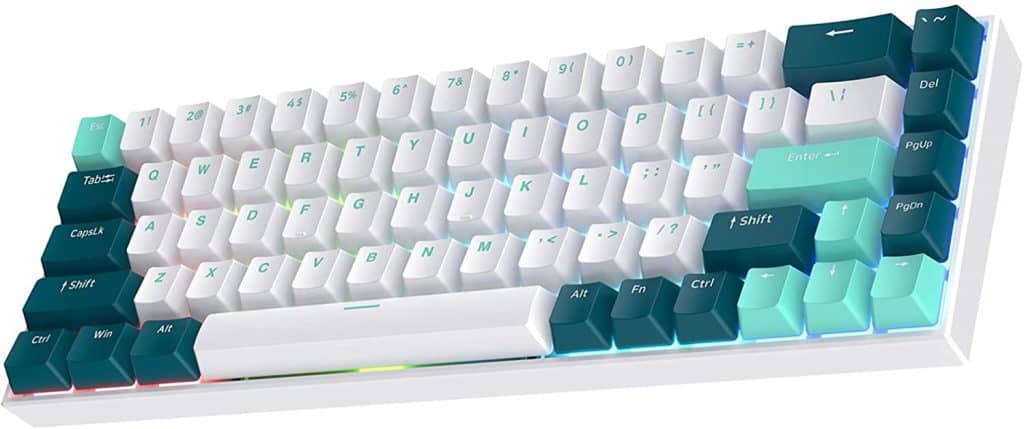Unlike full-sized keyboards that can occupy quite a bit of space, 60% and 65% keyboards are more compactly designed, take up considerably less space, and are much more portable.
Looking at these tiny keyboards, 60% and 65% are virtually the same for most casual gamers and desktop users. While they are much more similar to each other than to standard full-sized keyboards, there are some key differences between them.
This 60 vs 65 keyboard comparison article will compare the two and highlight the most important features of 60% and 65% keyboards. Moreover, we’ll answer several critical questions that will hopefully help you decide which keyboard type is the better pick for you.
60 vs 65 Keyboard – Quick Comparison
| Features | 60% Keyboard | 65% Keyboard |
|---|---|---|
| Number of Keys | 61 Keys | Between 66 and 68 Keys |
| Home Keys | No | No |
| Function Keys | No | No |
| Arrow Keys | No | Yes |
| Work Rating | 5/10 | 6/10 |
| Gaming Rating | 8/10* | 10/10 |
| General Use Rating | 7/10 | 7/10 |
*60% keyboards are generally outstanding for gaming but are unsuitable for sports games and other games that use arrow keys. Because of this lack of support, they get a lower grade than 65% keyboards.
60 Keyboard

60% keyboards are the more compact version of 65% keyboards, boasting even fewer keys and a narrower design. Here are the most important pros and cons of 60% keyboards:
Pros:
- Light and portable
- Excellent for most types of games
- Very flexible layout
- Take up very little space
Cons:
- Lacking several keys, including arrow keys
- Less than optimal for work
65 Keyboard

65% keyboards are slightly larger than 60% ones and include a handful of keys that make the user experience more convenient. Here are the biggest pros and cons of 65% keyboards:
Pros:
- Small and portable
- Have some keys that are missing in 60% keyboards
- Great for both gaming and work
- Slightly bigger than 60% keyboards
Cons:
- Lacking some essential keys
- Hard to adjust to for some users
What are 60% Keyboards?
Now that we’ve briefly listed the key features of 65% and 60% keyboards let’s discuss these two keyboard layouts in more detail, starting with the latter type. The 60% keyboard has an ultra-compact design with just 61 keys. This design maintains basic functionality but eliminates nearly all navigation keys and arrow keys.
The two biggest reasons consumers pick 60% are their size and portability properties. This compactness also means that 60% keyboards take up minimal space on your gaming desk or workstation. In return, you have more room on the table for your mouse and other gadgets.
Interestingly, you’ll also find that many 60% keyboards are also very programmable. As keyboard manufacturers had to compromise on many functional keys, many of them can offer multiple control options. For example, the top row of numbers can also double up as Fn controls. They are also very customizable, as most 60% keyboards have an identical design, so you can easily change keys and cases.
That said, it’s only fair to look at the other side of the coin. The fact that many essential standard keys are missing means that you’ll have to get used to accessing control options via different layers. You can reprogram these layers to set commands on the keys you pick, but this is often too much work for most casual users.
What Are 65% Keyboards?
65% keyboards are compact keyboards, very similar to 60% keyboards but with added keys to the right side. The extra keys are most often cursor keys and navigation keys. Generally, 65% keyboards have from 66 to 68 keys, so you’re still getting most of the functionality that you have with a full-size keyboard.
Looking at the layout of 65% keyboards, there’s not much difference for the most part. The only dissimilarity you’ll notice is on the right side of the keyboard, as the arrow keys are present in the bottom right corner.
The right shift is located above the left arrow key, while Page Up/Down, Home, and Delete buttons are aligned vertically above the right arrow button. This is the recognizable design of most 65% keyboards, although there can be slight design deviations.
There is one downside of 65% keyboards. Compared to 60% keyboards, 65% keyboards aren’t very customizable. In other words, you won’t find as many 65% keyboards that you can combine with custom cases or keys. Precise measurements between models from different manufacturers can vary slightly enough to make customization very challenging.
Features Face to Face
Design and Build
The 60% and 65% keyboards have a very minimalistic and compact design. There’s less space between the keys than on standard full-size keyboards. Besides that, there’s also no free real estate around the keyboard edges like in standard keyboards. Everything looks clean and takes up as little space as possible.
Most 60% and 65% keyboards are mechanical and not membrane. As these keyboards are available in various builds from many peripheral input device manufacturers, there’s no point in comparing 60% and 65% keyboards through this lens.
Moreover, the materials from which the keyboard is made also impact the overall build quality. For example, an aluminum-case keyboard will be much sturdier and more durable than a plastic-case keyboard.
Size
Before we go into the precise numbers, it’s important to know that 60% and 65% keyboard sizes are both terms coined by the keyboard community. Peripheral input device manufacturers don’t officially agree on this nomenclature.
So, 60% and 65% don’t have formally agreed upon measurements that keyboard manufacturers should abide by. We mention this because many different keyboard types could be listed as 60% and 65% keyboards.
That said, 60% and 65% keyboards don’t differ from each other that much in terms of physical size. For reference, standard keyboards are around 427.5 millimeters (16.8 inches) in width. Compared to the full-size standard keyboard, 65% keyboards are generally about 30% smaller. They are 305 millimeters (12 inches) wide. 60% keyboards are between 286 and 295 millimeters (around 11.5 inches) wide.
Performance
Comparing the overall performance of 60% and 65% keyboards when it comes to general usage, there aren’t any significant differences between the two, and you won’t notice any limitations. That said, as these keyboards do have a smaller number of keys compared to full-sized keyboards, you might notice some performance limitations depending on what activity you’re using them for.
For example, suppose you heavily rely on Fn function keys or home keys for quick alternate commands. In that case, you might feel restricted in your ability to quickly adjust settings, open emails, or tailor other basic functions. Neither 60% nor 65% keyboards have any Fn function keys.
Additionally, both 60% and 65% keyboards lack the number pad part that takes up a big portion of every full-sized keyboard. This doesn’t impact gamers and most professionals to any significant degree but might affect you if you regularly rely on calculator-style efficiency for entering numbers.
Lastly, there’s one more performance aspect that primarily concerns gamers. If you play sports games, most of which involve arrow keys, 60% keyboards are an impractical choice. You would have to set your movement controls on different keys, which is a bit impractical, especially if you’re used to using arrow keys when gaming. 65% keyboards include arrow keys, so your performance won’t be limited in this regard.
Portability
60% and 65% keyboards are significantly more portable than their full-sized counterparts. By taking away more than 35 keys in both cases and up to five inches in width, these keyboards are much more practical to carry around than standard keyboards.
This makes both of them suitable for frequent travelers and those who often work on the road. In this sense, there’s not much difference between 60% and 65% keyboards, as they are small, lightweight, and will barely take up any space in your bag.
Keycap Compatibility and Availability
Apart from performance, portability, and physical features, it’s also essential to consider future-proofing and keycap compatibility if any of your keys get broken or stop working.
More specifically, 60% and 65% keyboards have some deviations from the standard full-sized keyboard layout. Because of this, purchasing a 101, 104, or 105-key set as a backup for the keys on your 60% or 65% is not a good way to go about it. They won’t have the extra keys that you’ll need. At least not those that would fit in your 60% or 65% case.
So, the most important thing to watch for is keycap compatibility and the availability of essential 1U keys that get worn down the quickest. It doesn’t matter whether you get a 60% or 65% keyboard, as you’ll have to watch for this aspect for either model when buying one of these two compact keyboards.
Frequently Asked Questions
Are 65 keyboards good for gaming?
If you get a quality 65% keyboard, your gaming experience will feel almost the same as if you were playing on a full-sized keyboard. 65% are great for gaming and, generally, a better choice for this activity than 60% keyboards.
Are 60 keyboards better?
There’s no right or wrong answer on whether or not 60% keyboards are better than the 65% models. Both offer a limited number of keys compared to full-size keyboards, as they lack features like the number pad, function keys, and home keys. As 60% also lack arrow keys, they are a better choice if you need a minimalistic, light, and flexible keyboard.
Why do pros use 60 keyboards?
60% keyboards are popular among pros because they are very portable and easy to position when gaming. So, gamers that play for hours value this convenience significantly, as it allows them to position the keyboard as they like it best, even if they have a gaming station with limited space.
Are there other custom keyboard sizes besides the 60 and 65 keyboards?
Yes, the 60% and 65% keyboard sizes aren’t the only variations of the full-size computer keyboard. Most notably, you can also find 75% keyboards, which also come on most consumer laptops. Additionally, there are also 80% and 96% keyboards. What’s more, users that want the bare essential control features can even get a 40% keyboard.
Conclusion
Ultimately, as we dedicated most of this 60 vs 65 keyboard article to answering questions and listing features rather than comparing the two keyboard sizes, we’d say there’s no universal answer to which keyboard is superior. Both are significantly closer in size to each other than they are to a full-sized keyboard model and are equally portable, with the 65% keyboard being insignificantly bigger.
Keeping that in mind, if you’re looking for the most room possible and mostly play FPS, MOBA, and RPG games, 60% will likely suit you better. On the other hand, if you need a keyboard that will provide you with optimal performance for both gaming and other productivity tasks, 65% keyboards are the better pick. So, overall, it primarily depends on your preferences, as you won’t go wrong with either option regardless.